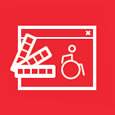Sé accesible, usable e incluyente
Cuando diseñamos contenido web, queremos ofrecer el mejor producto o servicio para que las personas puedan tener la mejor experiencia de usuario y vuelvan a nuestra empresa u organización.
Lo más importante es que todas las personas tengan acceso e igualdad de oportunidades independientemente de si tienen una discapacidad o no. Para tener éxito en ambos (usabilidad y accesibilidad), es necesario considerar algunos aspectos que comúnmente se pasan por alto.

Usabilidad
La usabilidad es una de las cualidades que hacen que una experiencia de usuario sea intuitiva, eficiente, efectiva y fácil de usar.

Diseño centrado en el usuario
Diseño centrado en el usuario es un enfoque para el desarrollo de software que tiene como objetivo hacer que los sistemas sean usables y útiles para los usuarios, enfocándose en sus necesidades, requisitos, preferencias y dificultades. Este enfoque mejora la eficacia y la eficiencia, el bienestar, la satisfacción, la accesibilidad y la sostenibilidad; y contrarresta los posibles efectos adversos del uso sobre la salud y la seguridad.

Diseño incluyente
El diseño incluyente es una metodología que da cabida a una gama completa de diversidad humana.

Diseño universal
Similar al diseño incluyente, el diseño universal es el diseño de productos y entornos para ser usables por todas las personas, en la mayor medida posible, sin necesidad de adaptación o diseño especializado.
En 1997 un grupo de trabajo de arquitectos, diseñadores de productos, ingenieros e investigadores de diseño ambiental en la Universidad Estatal de Carolina del Norte desarrolló los 7 principios:
- El diseño debe ser útil para todas las personas.
- El diseño se adapta a una amplia gama de preferencias y habilidades individuales.
- El uso del diseño es fácil de entender, sin importar la experiencia, conocimientos, habilidades del lenguaje o nivel de concentración del usuario.
- El diseño transmite la información necesaria de forma efectiva al usuario.
- El diseño minimiza riegos y consecuencias adversas de acciones involuntarias o accidentales.
- El diseño puede ser usado cómoda y eficientemente minimizando la fatiga.
- Proporcionar un tamaño y espacio adecuado para el acercamiento, alcance, manipulación y uso, independientemente del tamaño corporal, postura o movilidad del usuario.
Como buena práctica, hay consideraciones adicionales como la economía, la cultura, el género y las condiciones ambientales

Accesibilidad web
La accesibilidad web es cuando el contenido de sitios web, aplicaciones, herramientas y tecnologías están diseñados y desarrollados para que las personas con discapacidad puedan usarlos. La accesibilidad también beneficia a las personas sin discapacidad, por ejemplo: adultos mayores, personas con discapacidad temporal, personas que usan una lenta conexión a Internet, personas con limitaciones ambientales, personas que usan teléfonos móviles, relojes inteligentes, televisores inteligentes y otros dispositivos.
El contenido es accesible cuando está disponible para todos y la funcionalidad puede ser operada por cualquier persona. Eliminando los obstáculos a la hora de interactuar, transmitir, percibir o comprender información.
La accesibilidad mejora la usabilidad, aporta el beneficio de la autonomía y proporciona opciones eficientes y seguras para la educación, el empleo y las tareas cotidianas.

Discapacidades que afectan a la web
Las discapacidades pueden afectar la forma en que las personas usan la web. Hay múltiples razones y múltiples escenarios de usuarios con discapacidad visual, motriz, auditiva y cognitiva. Por ejemplo:

Legislación
La Convención sobre los Derechos de las Personas con Discapacidad se trata del primer instrumento amplio de derechos humanos del siglo XXI y la primera convención de derechos humanos que se abre a la firma de las organizaciones regionales de integración. Señala un “cambio paradigmático” de las actitudes y enfoques respecto de las personas con discapacidad.
La Convención se concibió como un instrumento de derechos humanos con una dimensión explícita de desarrollo social. En ella se adopta una amplia clasificación de las personas con discapacidad y se reafirma que todas las personas con todos los tipos de discapacidad deben poder gozar de todos los derechos humanos y libertades fundamentales. Se aclara y precisa cómo se aplican a las personas con discapacidad todas las categorías de derechos y se indican las esferas en las que es necesario introducir adaptaciones para que las personas con discapacidad puedan ejercer en forma efectiva sus derechos y las esferas en las que se han vulnerado esos derechos y en las que debe reforzarse la protección de los derechos.
- A fin de que las personas con discapacidad puedan vivir en forma independiente y participar plenamente en todos los aspectos de la vida, los Estados Partes adoptarán medidas pertinentes para asegurar el acceso de las personas con discapacidad, en igualdad de condiciones con las demás, al entorno físico, el transporte, la información y las comunicaciones, incluidos los sistemas y las tecnologías de la información y las comunicaciones, y a otros servicios e instalaciones abiertos al público o de uso público, tanto en zonas urbanas como rurales.

Estándar internacional, principios y pautas
La Iniciativa de Accesibilidad Web (WAI) del World Wide Web Consortium (W3C) en colaboración con individuos y organizaciones desarrolló las Pautas de Accesibilidad al Contenido Web 2.1 para que diseñadores, desarrolladores, autores de contenido, gerentes de proyectos, estudiantes, instructores, profesionales y personas con discapacidad sepan cómo hacer que el contenido web sea más accesible.
Hay 4 principios y dentro de los principios hay pautas.
Las 13 pautas que cumplen con los objetivos básicos para hacer que el contenido más accesible
La información y los componentes de la interfaz de usuario deben poder presentarse a los usuarios de maneras que puedan percibir.
1.1 Pauta: Alternativas de texto
Proporcione alternativas de texto para cualquier contenido que no sea de texto para que pueda cambiarse a otras formas que las personas necesitan, como letra grande, braille, voz, símbolos o lenguaje más simple.1.2 Pauta: Contenido Multimedia
Proporcione alternativas equivalentes para el contenido multimedia.1.3 Pauta: Adaptable
Cree contenido que se pueda presentar de diferentes maneras (por ejemplo, un diseño más simple) sin perder información o estructura.1.4 Pauta: Distinguible
Facilite a los usuarios ver y escuchar el contenido, incluida la separación del primer plano del fondo.Los componentes de la interfaz de usuario y la navegación deben ser operables.
2.1 Pauta: Teclado accesible
Haga que toda la funcionalidad esté disponible desde un teclado.2.2 Pauta: Tiempo suficiente
Proporcione a los usuarios tiempo suficiente para leer y usar el contenido.2.3 Pauta: Convulsiones
No diseñe el contenido de una manera que se sepa que causa convulsiones.2.4 Pauta: Navegable
Proporcione formas de ayudar a los usuarios a navegar, buscar contenido y determinar dónde se encuentran.2.5 Pauta: Modalidades de entrada
Haga que sea más fácil para los usuarios operar la funcionalidad a través de varias entradas más allá del teclado.La información y el funcionamiento de la interfaz de usuario debe ser comprensible.
3.1 Pauta: Legible
Haga que el contenido de texto sea legible y comprensible.3.2 Pauta: Predecible
Hacer que las páginas aparezcan y funcionen de manera predecible.3.3 Pauta: Asistencia de entrada
Ayude a los usuarios a evitar y corregir errores.El contenido debe ser lo suficientemente sólido como para que pueda ser interpretado por una amplia variedad de agentes de usuario, incluidas las tecnologías de asistencia.
4.1 Pauta: Compatible
Maximice la compatibilidad con los agentes de usuario actuales y futuros.

Tecnología de asistencia
Las tecnologías de asistencia son programas o equipos que las personas con discapacidad utilizan para mejorar su interacción con la web, como lectores de pantalla que leen en voz alta las páginas para personas que no pueden ver, lupas o magnificadores de pantalla para personas con algunos tipos de discapacidad visual, reconocimiento y comandos de voz y switches de selección para personas con discapacidad motriz que no pueden usar un teclado o un mouse.

Pruebas de accesibilidad
Para garantizar que el contenido web sea accesible, se debe simular la manera en que las personas con discapacidad navegarían en su entrono y con su tecnología de asistencia.
Debemos asegurarnos de considerar el cumplimiento de las pautas de accesibilidad en el ciclo de vida de desarrollo de software, de lo contrario encontraremos una gran cantidad de problemas que el equipo tendrá que solucionar. Es mejor si se prueba la accesibilidad en cada fase del proyecto y no sólo al final.
Hay dos tipos de pruebas:
Para las pruebas automatizadas hay una gran cantidad de opciones en línea gratuitas que ayudan, en algunos casos se ahorra tiempo y da un resultado preciso. Por ejemplo: validadores de contraste de color entre el fondo y el texto.
En otros casos, incluso si se utiliza la mejor herramienta, hay requisitos de accesibilidad que solo un humano puede definir como correctos. Por ejemplo, una herramienta automatizada puede mostrar el texto alternativo de una imagen, pero solo un humano puede decir si ese texto describe el contenido de la imagen.
Para las pruebas manuales, se tiene la opción de simular el escenario de la discapacidad visual, auditiva o motriz.
La prueba más común y efectiva es la de navegar como una persona ciega usando un lector de pantalla y solo teclado. Se puede utilizar NVDA para Windows o VoiceOver para Mac.
Otra opción es solicitar a las personas con discapacidad que hagan las pruebas y pedirles que piensen en voz alta para dar retroalimentación o comentarios de usabilidad y accesibilidad, también puede ser mediante una entrevista o una encuesta. También recomendamos ver o grabar las pruebas (pantalla e interacción del usuario) en caso de que otros miembros del equipo necesiten comprender mejor los desafíos o barreras que se encontraron.

Retroalimentación
Visita nuestro Ejemplo de encuesta sobre usabilidad y accesibilidad
Visita nuestra Matriz de Accesibilidad

